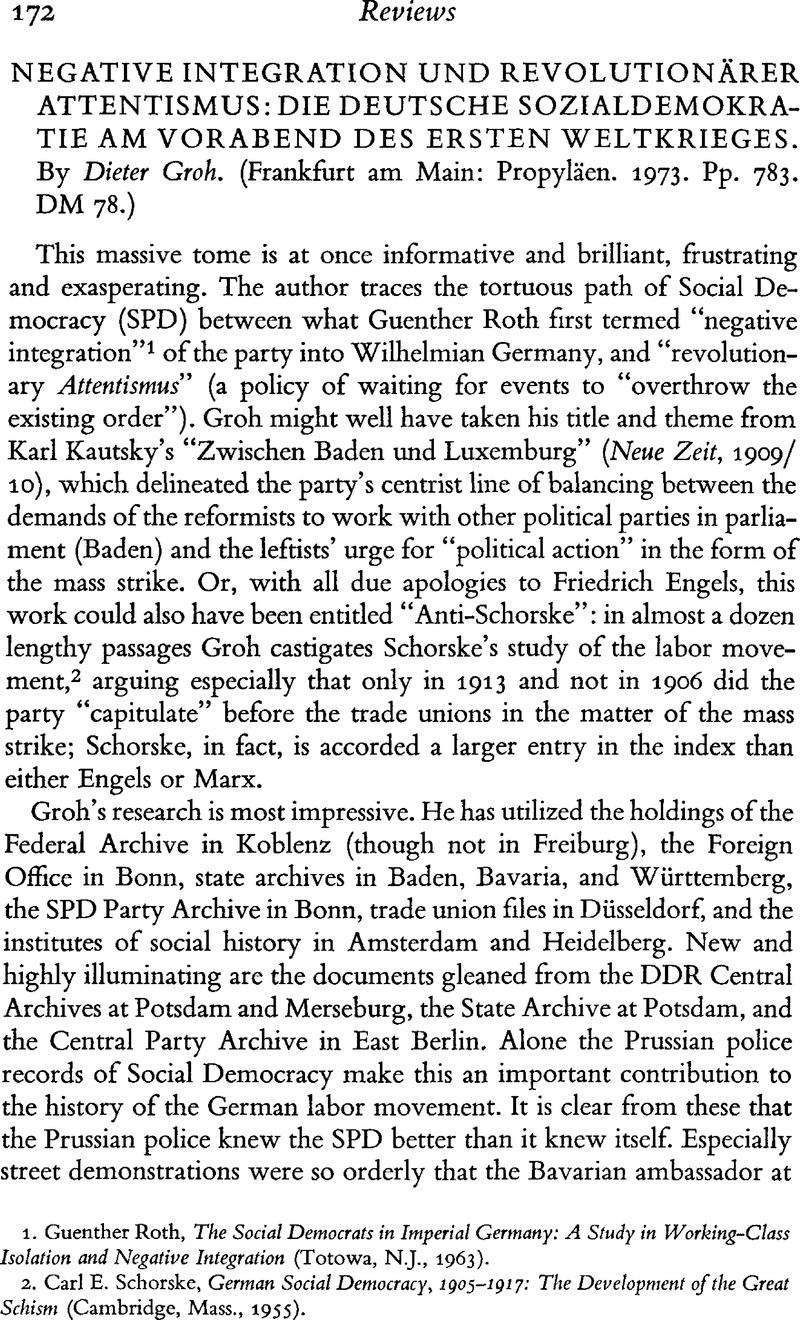Article contents
NEGATIVE INTEGRATION UND REVOLUTIONÄRER ATTENTISMUS: DIE DEUTSCHE SOZIALDEMOKRATIE AM VORABEND DES ERSTEN WELTKRIEGES. By Dieter Groh. (Frankfurt am Main: Propyläen. 1973. Pp. 783.DM 78.)
Published online by Cambridge University Press: 16 December 2008
Abstract

- Type
- Reviews
- Information
- Copyright
- Copyright © Conference Group for Central European History of the American Historical Association 1977
References
1. Roth, Guenther, The Social Democrats in Imperial Germany: A Study in Working-Class Isolation and Negative Integration (Totowa, N.J., 1963).Google Scholar
2. Schorske, Carl E., German Social Democracy, 1905–1917: The Development of the Great Schism (Cambridge, Mass., 1955).Google Scholar
3. Berghahn, Volker R., Der Tirpitz-Plan: Genesis und Verfall einer innenpolitischen Krisenstrategie unter Wilhelm II. (Düsseldorf, 1971);Google ScholarWitt, Peter-Christian, Die Finanzpolitik des Deutschen Reiches von 1903 bis 1913: Eine Studie zur Innenpolitik des Wilhelminischen Deutschland (Lübeck/Hamburg, 1970);Google ScholarStenkewitz, Kurt, Gegen Bajonett und Dividende: Die politische Krise in Deutschland am Vorabend des Erslen Weltkrieges (East Berlin, 1960); the literature of Fischer, Gasser, Geiss, et al., need not be cited here.Google Scholar
4. Sauer, Wolfgang, “Das Problem des deutschen Nationalstaates,” Politische Vierteljahresschrift 3 (1962): 159ff.Google Scholar
5. Hofstätter, Peter R., Gruppendynamik: Zur Kritik der Massenpsychologie (Hamburg, 1957), pp. 58ff;Google ScholarSiegrist, Johannes, Das Consensus-Modell: Studien zur Interaktionstheorie und zur kognitiven Sozialisation (Stuttgart, 1970), p. 8.Google Scholar
6. Groh here follows the arguments of Miller, Susanne, “Zum 3. August 1914,” Archiv für Sozialgeschichte 4 (1964): 515ff.,Google Scholar who stressed that the SPD's position as late as July 30 was still open to change. In a final thrust at Schorske, Groh argues that not in 1906 but during 1914/15 did positions in the SPD harden and ultimately lead to the schism of 1916 (pp. 715–16). It was only after August 4 that leftists such as Haenisch, Parvus-Helphand, Lensch, and Düwell, centrists such as Kautsky, Hilferding, and Eckstein, as well as revisionists such as Bernstein, Fischer, and Erdmann gravitated toward new positions. It will be interesting to see how Groh continues his “Anti-Schorske” in the ten-year installments of the history of the SPD that he plans to write.
7. Bundesarchiv Koblenz, Nachlass Bülow, Nr. 91, Friedrich von Holstein. Holstein to Bülow, July 30, 1900.
- 2
- Cited by


